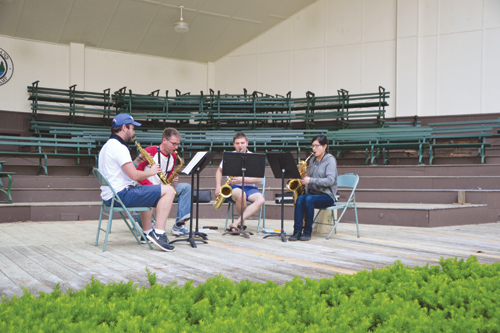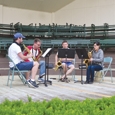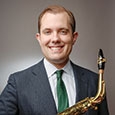
Fine chamber music is essential for students, giving them an opportunity to practice musical and technical concepts with the added benefit of musical collaboration, intonation development, and heightened musical decision-making skills. Even more than solo repertoire, the sheer number and unfamiliarity of much of the chamber woodwind repertoire can be a daunting task for the band director. Here are a few recommendations for saxophone chamber music.
Saxophone Duos
Fifteen Two-Part Inventions by J.S. Bach, arranged by Larry Teal (Presser), grades 3-4. These short works from one of the greatest composers of all time have been scored here for either two Bb saxophones, two Eb saxophones, or one Eb and one Bb instrument. They are all fairly short and make an excellent introduction to Baroque performance-practice.
Six Caprices by Pierre Max Dubois (Leduc), grades 4-5. These duets will provide great motivation to talented young performers. Scored for two altos, these duets provide myriad musical and technical challenges.
Six Canonic Sonatas by Georg Phillip Telemann, arranged by Larry Teal (Lauren Keiser Music Publishing), grades 3-4. While some of the included pieces may be relatively advanced, several of these pieces are perfect for intermediate saxophonists and will provide a wonderful challenge. This is excellent literature and will teach much about phrasing, sound, and intonation while introducing Baroque-era performance practice, something outside many saxophonists’ usual comfort zone.
Selected Duets for Saxophone, Volume 1 edited by Himie Voxman (Rubank/Hal Leonard), grades 2-3. Many of the earlier etudes in this collection work well for middle-school saxophonists, and style and technical demands are quite varied, offering a piece for nearly any occasion. Voxman offers up arrangements by many famous, composers, including Haydn, Purcell, and Stamitz. These will keep intermediate saxophonists busy for quite some time.
Selected Duets for Saxophone, Volume 2 edited by Himie Voxman (Rubank/Hal Leonard), grades 3-4. This collection includes increasingly difficult duets. Great literature from the Baroque through the Romantic eras is included, with composers such as Bach, Beethoven, and Telemann being represented. If the band can only afford two saxophone duet collections, Voxman’s are the ones to possess.
Saxophone Trios
The saxophone trio, unfortunately, has not been a popular chamber ensemble in the past several years. However, if a saxophone quartet is impossible to form, there is plenty of excellent music for a trio.
Trio, Op. 87 by Ludwig van Beethoven, arranged by Larry Teal (Lauren Keiser Music Publishing), grade 4. This wonderful, completely characteristic work of Beethoven’s was originally scored for two oboes and English horn but is arranged for either soprano, alto, and tenor or alto, tenor, and baritone saxophones. The work offers some technically difficult passages, but students will have to put the most work toward musicality. With the correct guidance, this work will help any young saxophonist grow immensely.
12 Saxophone Trios edited by Harry Gee (Alfred Publishing Company), grades 2-3. Published for either three altos or two altos and one tenor, these trios include an arrangement of Greensleeves, as well as transcriptions from many Baroque, Classical, and Romantic composers.
Adagio and Allegretto by James Hook, arranged by Harry Gee (Southern Music Company), grade 3. This pleasing work is taken from Hook’s Trio No. 4. It offers plenty of musical challenges for two alto players and one tenor player. Students must pay extremely close attention to style and intonation.
Chamber Music for Three Saxophones edited by Himie Voxman (Rubank/Hal Leonard), grades 1-3. This collection offers a wide variety of literature that will be extremely helpful for tonal and technical development of an AAT saxophone trio. These delightful pieces draw on works by the masters, including Beethoven, Brahms, Mozart, and Schubert.
Saxophone Quartets
Through the years, the vast majority of high-quality saxophone quartet literature has been penned for soprano, alto, tenor, and baritone, an instrumentation popularized early on by the Marcel Mule Quartet and since accepted as the main standard of instrumentation. Although a handful of SATB quartets are listed below, it is also extremely important for students without access to a soprano to still be able to perform in saxophone quartets. To that end, the first two quartet collections listed are highly recommended, with many pieces from both appearing on state solo and ensemble lists around the country.
Ten Saxophone Quartets edited by Larry Teal (G. Shirmer/(Hal Leonard), grades 2-5. This classic collection, arranged and compiled by the father of the American tradition of classical saxophone, is a wealth of excellent literature for the quartet. Arrangements from such musical masters as Bach, Beethoven, Haydn, Mozart, Schumann, and Tchaikovsky abound. Level of difficulty varies, but each arrangement takes into consideration the viability of each instrument in the quartet as a solo voice and equal member. Rarely are the bottom three voices relegated to back-up status; instead, each saxophonist is challenged to step up.
Quartet Repertoire for Saxophone edited by Himie Voxman (Rubank/Hal Leonard), grade 2-4. This collection also offers many high-quality transcriptions by legendary composers, including Bach, Beethoven, Brahms, Mozart, and Telemann. Arrangements are varied in style and difficulty with some being quite short and simple, while others will be both quite musically and technically challenging for many high school saxophonists. In most of these arrangements, each saxophonist will have a turn at both melodic and accompanimental material.
Fugue in G Minor by J.S. Bach, arranged by J. Michael Leonard (Masters Music Publications), grade 3. The Little Fugue in G Minor as it is known to many, is wonderful for the development of a saxophone quartet. Scored for soprano, alto, tenor, and baritone, this piece calls upon the young musicians to perform as equals: the baritone player pulls just as much weight as the soprano player does. This contrapunctal work is perfect for discussing timbral and stylistic blend, as well as exposing saxophonists to a classic of Baroque literature. It is on the difficult end of the grade level.
Quartet (Allegro de Concert) by Caryl Florio (Edition Peters), grade 4. This work is the earliest known saxophone quartet piece written in North America, receiving its premiere at the hands of Edward Lefebre and other members of Patrick Gilmore’s ground-breaking band. Aside from the historical context, this work is a marvelous Romantic piece for SATB groups. The Andante movement is beautiful and serene (and will give young saxophonists experience in flat key signatures rarely experienced in band music), while the tempo of the Allegro movement can be successfully adjusted, yielding a pleasing performance at several possible speeds.
The Arrival of the Queen of Sheba by G.F. Handel, arranged by Jean-Yves Fourmeau (Billaudot), grade 4. This wonderful arrangement requires strong performers, especially on soprano. However, this will offer a great challenge to an advanced high school quartet and will shed light on an excellent example of Handel’s music, to which many young performers have scant access.
Quatuor pour saxophones by Faustin and Maurice Jeanjean (Editions Salabert), grade 5 (although internal movements are less difficult). This classic work, in its entirety, is perfect for more advanced high school groups. However, the second and third movements are possibilities for slightly less skilled groups if the soprano saxophonist is a strong player. This is pleasing and lush music, made up of four character-piece movements, each painting a story of rural French life in an earlier time. Movements include “The Happy Villagers,” Two Paths,” “Butterflys (Scherzo),” and “Concert in the Park (Humoresque).” This work provides a great many musical challenges while being incredibly pleasing to audiences.
Five Bach Chorales transcribed by John Nichol (Watchdog Music Publishers), grade 2. Available for both SATB and AATB quartets, these five chorales, technically, are performable by middle school saxophonists. However, the musical possibilities involved can keep saxophonists occupied to graduate school. These excellent transcriptions of five of Bach’s most-loved chorale settings are worthy ensemble literature for any level of student. The development of sound, intonation, phrasing, and musical communication gained through these chorales will be invaluable.
Sonata No. 44 by Domenico Scarlatti, arranged by Frederick L. Hemke (Southern Music). grade 4. This excellent SATB transcription from Scarlatti’s keyboard original requires much musical awareness across the ensemble. However, the work is quite brief, so it may be just the challenge fine young performers need.
Conclusion
This list is only a beginning to the wonderful universe of chamber music for saxophones. Start students of all instruments on chamber music early, so they can grow in technique and musicality and see that chamber music is a perfect, fun avenue for life-long music making.






